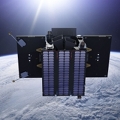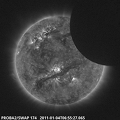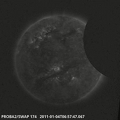Sun, Moon and Earth line up for PROBA2
6 January 2011
ESA's PROBA2 microsatellite experienced a conjunction of the spheres on Tuesday, as the Sun, Moon and Earth all lined up in front of it.As people on the ground observed the 4 January partial solar eclipse, PROBA-2 provided a privileged top-of-atmosphere view – at least briefly. Shortly after the Moon partially blocked PROBA-2's view of the Sun, the Sun-watching satellite flew into Earth's shadow. At that point – when the video seen here goes dark – the Sun, Moon, Earth and PROBA-2 were all on the same line in space.
 |
|
Illustration of the PROBA-2 spacecraft |
The images making up this video were observed by PROBA-2 with its SWAP imager – designed and operated by ROB – which operates at extreme-ultraviolet (EUV) wavelengths to monitor the swirling layer of the solar corona just above the Sun's surface.
 |
|
Eclipse seen from the Netherlands |
"We had to work very hard to get this high-resolution pointing needed for these images," explained David Berghmans, SWAP's principal investigator, adding that with the whole of Proba-2 less than a cubic metre in volume, SWAP is only the size of a large shoe box.
 |
|
PROBA-2's initial eclipse view |
"And, as far as I am aware, the Mayans did not predict this alignment should cause concerns!"
The event proved scientifically useful for LYRA, PROBA-2's other Sun-monitoring instrument normally used to track solar radiation intensity, explained LYRA principal investigator Marie Dominique: "While the EUV sunset–sunrise season blinds SWAP, it allows LYRA to track the amount of solar EUV light passing through Earth's atmosphere, which helps determine its particle content."PROBA-2's eclipse season
 |
|
Earth's atmosphere blocks much of the EUV light |
Because both SWAP and LYRA are observing in particular areas of the EUV spectrum, these instruments experience gradually progressing EUV sunsets (and sunrises), as the light in question is absorbed by lower layers of the terrestrial atmosphere.
The satellite continues to operate well during this eclipse season, and in some cases scientifically-useful data can be gathered – by tracking how much EUV light is blocked, LYRA gains insight into atmosheric composition, for example.
PROBA-3: blotting out the Sun
 |
|
Illustration of PROBA-3 spacecraft |
Scheduled for 2015-16, PROBA-3 will comprise two formation flying satellites, with one casting the other into shadow to allow ongoing observation of the faint outer layers of the still-mysterious solar corona.
(Note: This article was originally published on the ESA Technology Portal.)

